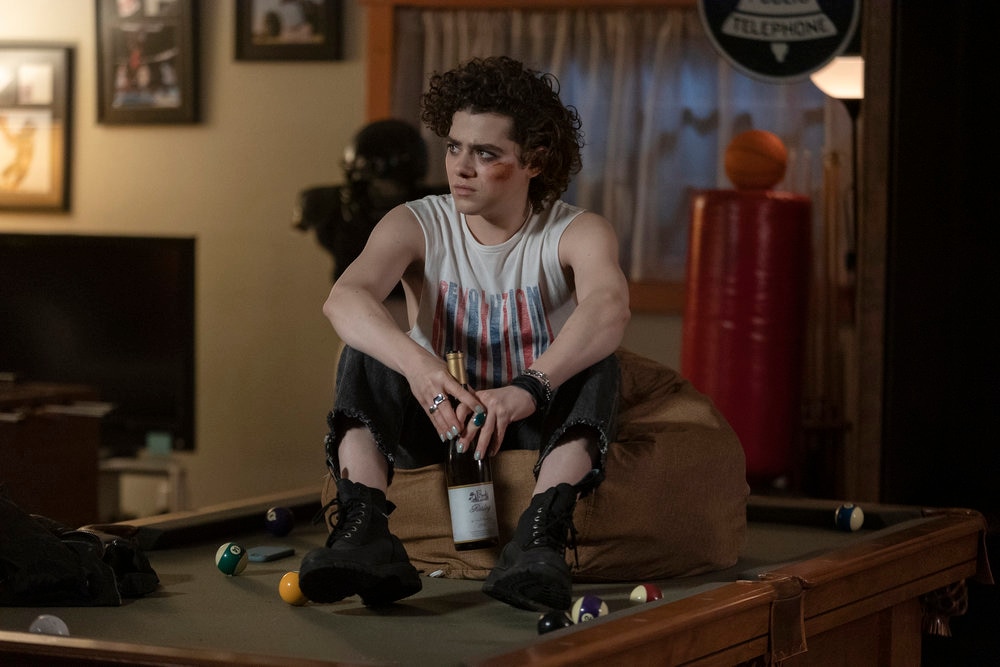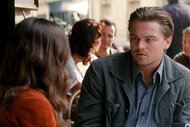Create a free profile to get unlimited access to exclusive videos, sweepstakes, and more!
Peacock's 'The Girl in the Woods' brings non-binary representation to monster hunting
Executive Producer Krysten Ritter discusses the journey that led to that emotional coming out scene.

Popular culture has come a long way since Buffy the Vampire Slayer first premiered in 1997. Now, the heroes populate the genre-themed worlds of television and film are more diverse than they've ever been, with movies like Netflix's Fear Street trilogy featuring people of color as protagonists and centering queer romances. (Buffy itself could barely have its main lesbian couple kiss on screen, and even then, the romance wasn't as spoken about.)
Peacock's The Girl in the Woods continues this trend with its trio of main characters.
There's Carrie (Insidious Chapter 3's Stefanie Scott), the titular "girl in the woods," a teenage warrior who was chosen to become the guardian of a mysterious door (also in the woods), to help keep the monsters on the other side from escaping into the human world and wreaking havoc and taking lives. However, when she chooses to run away from the cultish "colony" she was raised in, she's taken in and becomes friends with Tasha (I Am Not Okay With This's Sofia Bryant) and Nolan (Freaky's Misha Osherovich), a pair of best friends also feeling the suffocation of West Pine, the small Pacific Northwest mining town they currently live in. While Tasha is raised by a single father who is now an out-of-work miner, Nolan's wealthy environmentalist mother is the one responsible for shutting down the local mine and putting most of the townspeople out of business.
"[Showrunner] Jane Casey Modderno did such a good job with the writing and the characters. She is a very exciting writer because she never feels formulaic. The characters always felt very fresh and original and unexpected." Executive Producer Krysten Ritter (Netflix's Nightbooks), who also directed the first four episodes of the series, tells SYFY Wire. "That's really what drew me so much to the project. And that's a testament to the fantastic writing."
One of the ways The Girl in the Woods flips the script is by having the colony Carrie comes from be more tolerant of different genders and sexualities, despite its brutal traditions and rituals. This is a sharp contrast to the people of West Pine, who don't seem to understand Nolan, something even Tasha struggles with, having assumed her best friend might be queer despite Nolan having said otherwise.
However, as Nolan eventually confides in Carrie, they are non-binary — not gay, like everyone else in their small town seems to think. This causes conflict between Nolan and Tasha, who both have feelings for each other, but are not sure how to navigate them, and adds a degree of closeness between Nolan and Carrie, who herself had been attracted to a rival warrior in training, Sara (Kylie Liya Page, Step Up).
"Being in a small town and not feeling like you can be your true self was always part of it. Every choice, every piece of clothing was very deliberate," explains Ritter, who worked with Oshervich, who is non-binary themselves, to craft the four-episode arc that culminates in Nolan's finally vocalizing how they feel. "Also, [in] the opening scene [for] Nolan's character, you see them being exactly who they want to be in their bedroom on the phone with their best friend. And putting on the makeup that they want. And then they look out the window and are reminded of where they are. And just sit in the mirror and take it off. It's just a visual small thing, but it was so meaningful."
Ritter goes on to add, "We wanted to have a character that is just trying so hard to survive where they are. And trying to figure that out and finally coming to a place where they can be and say who they are was such a beautiful thing. And we're so proud to tell that story in an authentic way."
Unfortunately for Carrie, Tasha, and Nolan, their teenage troubles must wait as monsters do indeed escape from the door and begin preying on the people of West Pine, starting with members of Nolan's family. While most of the monsters are humanoid in their general shape, their designs are still otherworldly creepy, something Ritter did intentionally when it came to crafting the look and feel of the series, having worked with the same monster-designing team behind Stranger Things to create creature designs that were original. It's something she also aimed for when it came to the cult-like colony Carrie and Sara were raised in.
"I wanted the cult and the Colony to be unlike things that we've seen," explains Ritter. "And then have that character take us into the modern world. And then Nolan and Tasha are the ones who bring color. We go from this monochrome, dark, bleak colony to color and vibrance and electricity."
The show is based on Crypt TV's 2018 short film, The Door in the Woods, which then received a 2020 sequel film titled The Girl in the Woods. However, Ritter cites Buffy as an inspiration for her take on this particular fictional universe, along with some other titles.
"A lot of my favorite things are all reference points in this," she says. "It was a lot of The Lost Boys, The Craft, My So-Called Life, Scream, Requiem for a Dream and The Handmaid's Tale. [Those] were all things that I would touch on."
The Girl in the Woods is available to stream on Peacock.


























